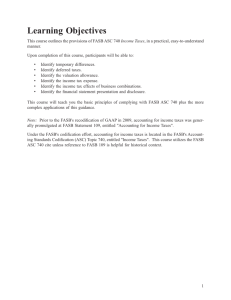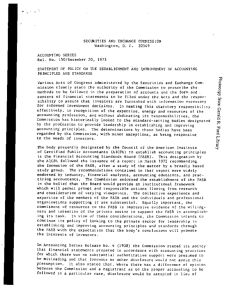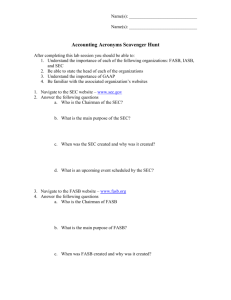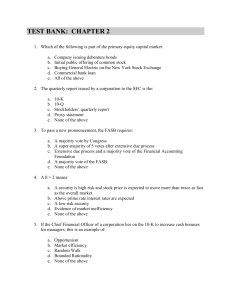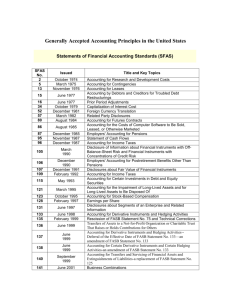Insights, May 28, 2008
advertisement
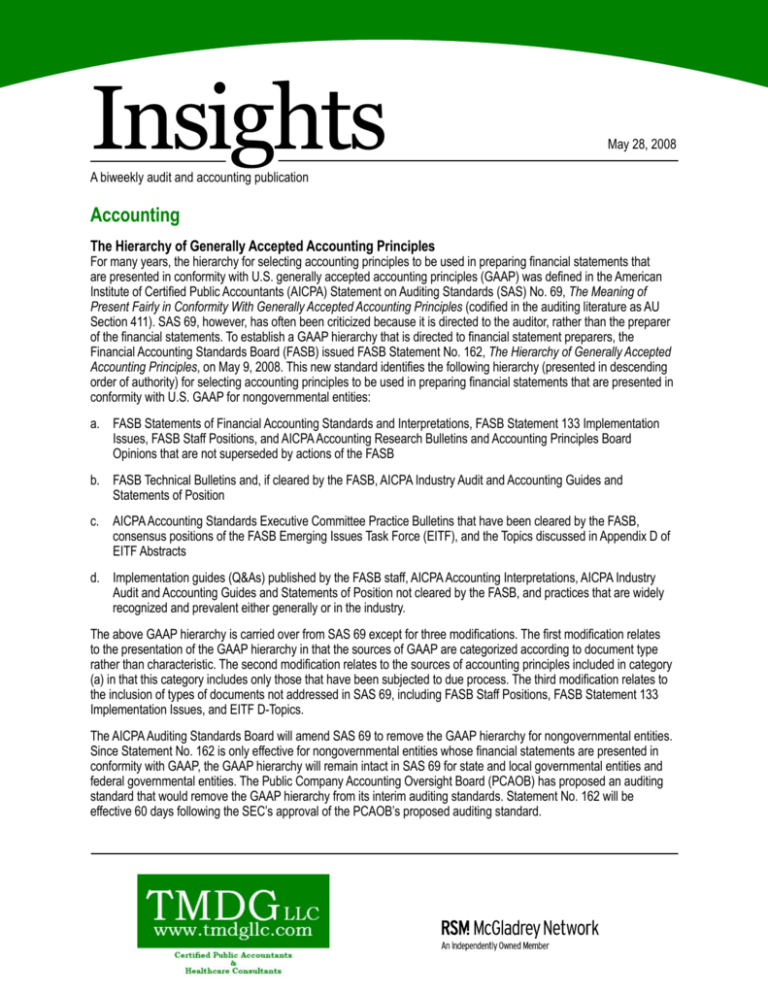
Insights May 28, 2008 A biweekly audit and accounting publication Accounting The Hierarchy of Generally Accepted Accounting Principles For many years, the hierarchy for selecting accounting principles to be used in preparing financial statements that are presented in conformity with U.S. generally accepted accounting principles (GAAP) was defined in the American Institute of Certified Public Accountants (AICPA) Statement on Auditing Standards (SAS) No. 69, The Meaning of Present Fairly in Conformity With Generally Accepted Accounting Principles (codified in the auditing literature as AU Section 411). SAS 69, however, has often been criticized because it is directed to the auditor, rather than the preparer of the financial statements. To establish a GAAP hierarchy that is directed to financial statement preparers, the Financial Accounting Standards Board (FASB) issued FASB Statement No. 162, The Hierarchy of Generally Accepted Accounting Principles, on May 9, 2008. This new standard identifies the following hierarchy (presented in descending order of authority) for selecting accounting principles to be used in preparing financial statements that are presented in conformity with U.S. GAAP for nongovernmental entities: a. FASB Statements of Financial Accounting Standards and Interpretations, FASB Statement 133 Implementation Issues, FASB Staff Positions, and AICPA Accounting Research Bulletins and Accounting Principles Board Opinions that are not superseded by actions of the FASB b. FASB Technical Bulletins and, if cleared by the FASB, AICPA Industry Audit and Accounting Guides and Statements of Position c. AICPA Accounting Standards Executive Committee Practice Bulletins that have been cleared by the FASB, consensus positions of the FASB Emerging Issues Task Force (EITF), and the Topics discussed in Appendix D of EITF Abstracts d. Implementation guides (Q&As) published by the FASB staff, AICPA Accounting Interpretations, AICPA Industry Audit and Accounting Guides and Statements of Position not cleared by the FASB, and practices that are widely recognized and prevalent either generally or in the industry. The above GAAP hierarchy is carried over from SAS 69 except for three modifications. The first modification relates to the presentation of the GAAP hierarchy in that the sources of GAAP are categorized according to document type rather than characteristic. The second modification relates to the sources of accounting principles included in category (a) in that this category includes only those that have been subjected to due process. The third modification relates to the inclusion of types of documents not addressed in SAS 69, including FASB Staff Positions, FASB Statement 133 Implementation Issues, and EITF D-Topics. The AICPA Auditing Standards Board will amend SAS 69 to remove the GAAP hierarchy for nongovernmental entities. Since Statement No. 162 is only effective for nongovernmental entities whose financial statements are presented in conformity with GAAP, the GAAP hierarchy will remain intact in SAS 69 for state and local governmental entities and federal governmental entities. The Public Company Accounting Oversight Board (PCAOB) has proposed an auditing standard that would remove the GAAP hierarchy from its interim auditing standards. Statement No. 162 will be effective 60 days following the SEC’s approval of the PCAOB’s proposed auditing standard. 1 Statement No. 162 is not intended to change any accounting requirements. However, in the unlikely event Statement No. 162 does cause a change in accounting, that change is to be reported as a change in accounting principle in accordance with FASB Statement No. 154, Accounting Changes and Error Corrections. FASB Statement No. 162 is available in full at http://www.fasb.org/pdf/fas162.pdf. Accounting for Convertible Debt Instruments that May Be Settled in Cash Emerging Issues Task Force (EITF) Issue No. 90-19, “Convertible Bonds with Issuer Option to Settle for Cash upon Conversion,” currently provides accounting guidance for certain types of convertible debt instruments that may be settled in cash upon conversion. One of those instruments, referred to as Instrument C in that Issue, requires that, upon conversion, the issuer satisfy the accreted value of the obligation in cash and the conversion spread in either cash or stock. The consensus in Issue 90-19 required that Instrument C be accounted for as convertible debt (i.e., no portion of the proceeds from the issuance of the convertible debt securities should be accounted for as attributable to the conversion feature in accordance with the guidance in paragraph 12 of Accounting Principles Board (APB) Opinion No. 14, Accounting for Convertible Debt and Debt Issued with Stock Purchase Warrants). However, Issue 90-19 also prescribed a diluted earnings-per-share methodology that was consistent with debt issued with detachable warrants. As a result, Instrument C generally has had less of a dilutive effect on the calculation of diluted earnings per share than a convertible debt instrument that requires application of the if-converted method. Because of the proliferation of such instruments in the marketplace over the past several years, questions have been raised as to whether the accounting guidance in Issue 90-19 appropriately reflected the economic effects of those instruments. The Financial Accounting Standards Board (FASB) believes that the inconsistency between the accounting for such instruments (as convertible debt) and the diluted earnings-per-share treatment (as debt issued with detachable warrants) can provide misleading information to investors. The FASB therefore has issued FASB Staff Position (FSP) No. APB 14-1, Accounting for Convertible Debt Instruments That May Be Settled in Cash upon Conversion (Including Partial Cash Settlement), to provide guidance on the accounting for certain types of convertible debt instruments that may be settled in cash upon conversion. The FSP applies to convertible debt instruments that, by their stated terms, may be settled in cash (or other assets) upon conversion, including partial cash settlement, unless the embedded conversion option is required to be separately accounted for as a derivative under FASB Statement No. 133, Accounting for Derivative Instruments and Hedging Activities. The FSP clarifies that convertible debt instruments within its scope are not addressed by paragraph 12 of Opinion No. 14. The initial measurement guidance in the FSP requires issuers to separately account for the liability and equity components of convertible debt instruments within its scope. The objective of this treatment is to reflect the issuer’s nonconvertible debt borrowing rate when interest cost is recognized in subsequent periods. To accomplish this objective, the issuer must first determine the carrying amount of the liability component by measuring the fair value of a similar liability (including any embedded features other than the conversion option) that does not have an associated equity component. The issuer must then determine the carrying amount of the equity component represented by the embedded conversion option by deducting the fair value of the liability component from the initial proceeds ascribed to the convertible debt instrument as a whole. This exercise may result in a temporary difference between the carrying value of the debt component for financial-reporting purposes and for income tax purposes. If so, deferred income taxes would be recognized on that temporary difference with an adjustment to additional paid-in capital. The subsequent measurement guidance in the FSP requires the application of other U.S. generally accepted accounting principles to the liability and equity components. The excess of the principal amount of the liability component over its carrying amount should be amortized to interest cost using the interest method, as described in APB Opinion No. 21, Interest on Receivables and Payables. The equity component (conversion option) is not remeasured as long as it continues to meet the conditions for equity classification in EITF Issue 00-19, “Accounting for Derivative Financial Instruments Indexed to, and Potentially Settled in, a Company’s Own Stock.” If an instrument within the scope of the FSP is derecognized, the consideration transferred and transaction costs incurred in the extinguishment of the liability component and reacquisition of the equity component are allocated to those components using the same methodology that was applied upon the original recognition. The FSP also requires certain incremental disclosures about the terms of the convertible debt instruments within the scope of the FSP and to provide an understanding of how those instruments have been reported in the issuer’s financial statements. 2 The FSP is effective for financial statements issued for fiscal years beginning after December 15, 2008, and interim periods within those fiscal years, and generally should be applied retrospectively to all periods presented. Early adoption is not permitted. The FSP is available in full at http://www.fasb.org/pdf/fsp_apb14-1.pdf. Auditing The Shifting Paradigm in Business Reporting and Assurance Significant changes are impacting the format, content, and reliability of business information that is exchanged in today’s markets. While most external communications are now compliance-oriented and focused on historical financial statements, there is increasing pressure on organizations to include in external communications the kinds of information used by internal management to run businesses. There also is increasing demand, by both internal and external users of business information, for more timely information provided in a standard, electronic format allowing for quick and easy analysis. The current static, paper-based model is being replaced by an online model that is available on demand. As the reporting model evolves to leverage greater capabilities and address emerging needs, independent assurance must adapt accordingly. The AICPA Assurance Services Executive Committee (ASEC) therefore has released a whitepaper, The Shifting Paradigm in Business Reporting and Assurance, to highlight significant trends that give rise to emerging reporting and assurance opportunities and needs. The whitepaper also lays out key milestones to be addressed by market participants in order to maximize the quality, transparency, and relevance of reported information, and discusses efforts that are already underway in that regard, such as Enhanced Business Reporting and eXtensible Business Reporting Language. The whitepaper explores the following topics, among others: • The current state of business reporting and assurance • Forces of change and implications for the future of reporting and assurance • Critical milestones and the respective roles and responsibilities of corporate reporting participants • Leadership responsibility of the accounting profession Bob Dohrer, member of the ASEC and practice leader for our International Assurance Services Group, commented on the whitepaper, “While this whitepaper takes a close look at the current state of business reporting and assurance, it is also a forward-looking document. The analysis includes ideas for migrating toward a model that will better address future reporting needs, challenges, and opportunities.” The subject matter outlined in the whitepaper is of interest to those in the accounting profession and other participants in the business reporting process, including producers and consumers of business information. The whitepaper is available in full at http://www.aicpa.org/Professional+Resources/Accounting+and+Auditing/BRAAS/downloads/AICPA_ ASEC_Whitepaper_Final_20082008April_2008.pdf. Financial Institutions Applying Statement No. 157 to Other Real Estate Owned On the balance sheet of a financial institution, “other real estate owned” includes property acquired through foreclosure and by deed in lieu of foreclosure. FASB Statements No. 15, Accounting by Debtors and Creditors for Troubled Debt Restructurings, and No. 144, Accounting for the Impairment or Disposal of Long-Lived Assets, establish guidance on accounting for and reporting of foreclosed assets. Statement No. 144 requires that long-lived assets to be disposed of be reported at the lower of carrying amount or fair value less cost to sell. FASB Statement No. 157, Fair Value Measurements, provides guidance for using fair value to measure assets and liabilities. It clarifies the principle that fair value should be based on the assumptions market participants would use when pricing the asset or liability. In support of this principle, the standard establishes a three-level fair value hierarchy 3 that prioritizes the information used to develop those assumptions. Under the standard, fair value measurements are separately disclosed by level within the fair value hierarchy. Financial institutions need to remember that Statement No. 157 did not alter the requirement to record other real estate owned at the lower of cost or fair value less costs to sell. The effective date of Statement No. 157 will be deferred until years beginning after November 15, 2008 if the financial institution elects the deferral for nonfinancial assets, which includes other real estate owned, pursuant to FASB Staff Position No. FAS 157-2, Effective Date of FASB Statement No. 157. Management frequently uses the work of a real estate appraiser as evidential matter supporting fair value measurements of real estate investments and assets collateralized by real estate. A recent appraisal may initially be considered to be a Level 2 measurement under the fair value hierarchy of Statement No. 157; however, adjustments to the valuation of certain real estate assets may be needed depending on factors specific to the asset. Those factors include the condition and/or location of the asset, the extent to which the inputs relate to items that are comparable to the asset, and the volume and level of activity in the market within which the inputs are observed. An adjustment that is significant to the fair value measurement in its entirety might render the measurement a Level 3 measurement, depending on the level in the fair value hierarchy within which the inputs used to determine the adjustment fall. The level at which the fair value measurement is determined may affect the disclosures that are required by Statement No. 157. Risks of Separate-Account Bank-Owned Life Insurance Many financial institutions invest in bank-owned life insurance (BOLI). While the majority of financial institutions invest in general-account BOLI, some financial institutions have investments in separate-account BOLI. With general-account BOLI, the general assets of the life insurance company support the policyholder’s cash surrender value. In separateaccount BOLI, the cash surrender value is supported by investment assets generally identified by the insurance company, which segregates those assets from its general assets. When a financial institution purchases separate-account BOLI, it assumes the risk of decline in the fair values of the assets held in the separate account. Thus, a decline in the value of the separate-account assets could lead to impairment of the institution’s BOLI asset. Some separate account policies include a stable value protection (SVP) feature. An SVP feature protects the financial institution against a shortfall between the fair value and cost basis of the separate-account assets when the policy owner surrenders the policy. However, the protection provided by the SVP feature is usually limited to a percentage of the decline in fair value (e.g., 20 to 25%). As a result, an owner of separate-account BOLI has the following risks: • Declines in fair value of the separate-account assets; and • Credit risk related to the counterparty of the SVP feature. Financial institutions owning separate-account BOLI will want to update the impairment analysis of the separateaccount assets on a regular basis. If an SVP feature is included in the life insurance contract, the financial institution should obtain information as to the credit standing of the counterparty to the SVP feature. Public Sector Proposed M&A Accounting by Not-for-Profit Organizations In October of 2006, the Financial Accounting Standards Board (FASB) issued an Exposure Draft of a Proposed Statement, Not-for-Profit Organizations: Mergers and Acquisitions, which proposed requiring the application of the acquisition method to all mergers and acquisitions by a not-for-profit organization. Recently, the FASB made a tentative decision to revise this proposed Statement to distinguish a merger of two or more not-for-profit organizations from an acquisition of another entity (business or nonprofit activity) by a not-for-profit organization. The FASB has tentatively agreed that in a merger, the governing bodies of two or more not-for-profit organizations cede control of those organizations to create a new organization. “Control” is defined as the direct or indirect ability to determine the direction of management and policies through ownership, contract, or otherwise. The tentative decision would require the carryover basis as the method of accounting for mergers, with acquisitions to be accounted for at the fair value of the assets and liabilities acquired. 4 The FASB is now seeking comments on the appropriateness and workability of potential criteria for distinguishing a merger from an acquisition. Those wishing to provide comments are invited to do so prior to July 8, 2008 and are asked to respond to five specific questions, which are detailed at http://www.fasb.org/commentrequest.pdf. SEC SEC Proposes Requirement for Data Tagging The SEC has proposed a rule which, if approved, would require U.S. public companies with $5 billion or more of worldwide public float that use U.S. generally accepted accounting principles (GAAP) to prepare their financial statements to electronically tag financial data using extensible business reporting language (XBRL) software in reports for periods ending in late 2008. The remaining public companies using U.S. GAAP would provide this disclosure over the following two years. Companies using International Financial Reporting Standards to prepare their financial statements would be required to electronically tag financial data for fiscal periods ending in late 2010. Early adoption of the SEC’s requirement would be permitted. XBRL is a language for the electronic communication of business and financial data that codes individual bits of information, such as sales, allowing for easier comparison of results across companies or time periods. The tagging initially would cover financial statements, with block tags for footnotes and schedules; the SEC eventually would require individual tags for all items, including footnotes. Under the SEC’s proposal, companies must include datatagged results as an exhibit to their quarterly and annual reports and also would be required to post this information on their Web sites. The SEC’s proposal will be available for comment until July 13, 2008 at www.sec.gov. Insights is a biweekly publication of TMDG, LLC and should not be construed as accounting, auditing, consulting, or legal advice on any specific facts or circumstances. The contents are intended for general information purposes only. Please contact Matthew B. Dubnansky at TMDG, LLC at 410.385.5236 or mbdubnansky@tmdgllc.com for more information. TMDG, LLC is an independently owned member of the RSM McGladrey Network. RSM McGladrey Network is the premier affiliation of independent accounting and consulting firms in the United States that leverages the resources of RSM McGladrey. RSM McGladrey is a leading provider of financially focused business services to midsized companies. The RSM McGladrey group of companies offers accounting, tax services, business consulting, retirement resources, employer services, corporate finance, wealth management and financial process outsourcing. RSM McGladrey and McGladrey & Pullen, a CPA firm, have an alternative practice structure. Though separate and independent legal entities, RSM McGladrey and McGladrey & Pullen work together to serve clients’ business needs. They are members of RSM International, an affiliation of separate and independent legal entities. Information provided in this publication has been obtained by TMDG, LLC and McGladrey & Pullen from sources believed to be reliable. However, TMDG, LLC and McGladrey & Pullen guarantee neither the accuracy nor completeness of any information and are not responsible for any errors or omissions or for results obtained by others as a result of reliance upon such information. This publication does not, and is not intended to, provide legal, tax or accounting advice. 5


